#Indian Himalayan region
Text

#Himachal Pradesh travel#Top tourist destinations#Indian Himalayan region#Adventure in Himachal#Nature exploration#Cultural experiences#Hill stations in Himachal#Best places to visit#Vacation spots in India#Himachal Pradesh attractions#Scenic landscapes#Travel guide#Incredible India#Mountain getaways#Himachal vacation tips
0 notes
Text

Despite its green image, Ireland has surprisingly little forest. [...] [M]ore than 80% of the island of Ireland was [once] covered in trees. [...] [O]f that 11% of the Republic of Ireland that is [now] forested, the vast majority (9% of the country) is planted with [non-native] spruces like the Sitka spruce [in commercial plantations], a fast growing conifer originally from Alaska which can be harvested after just 15 years. Just 2% of Ireland is covered with native broadleaf trees.
Text by: Martha O’Hagan Luff. “Ireland has lost almost all of its native forests - here’s how to bring them back.” The Conversation. 24 February 2023. [Emphasis added.]
---
[I]ndustrial [...] oil palm plantations [...] have proliferated in tropical regions in many parts of the world, often built at the expense of mangrove and humid forest lands, with the aim to transform them from 'worthless swamp' to agro-industrial complexes [...]. Another clear case [...] comes from the southernmost area in the Colombian Pacific [...]. Here, since the early 1980s, the forest has been destroyed and communities displaced to give way to oil palm plantations. Inexistent in the 1970s, by the mid-1990s they had expanded to over 30,000 hectares. The monotony of the plantation - row after row of palm as far as you can see, a green desert of sorts - replaced the diverse, heterogenous and entangled world of forest and communities.
Text by: Arturo Escobar. "Thinking-Feeling with the Earth: Territorial Struggles and the Ontological Dimension of the Epistemologies of the South." Revista de Antropologia Iberoamericana Volume 11 Issue 1. 2016. [Emphasis added.]
---
But efforts to increase global tree cover to limit climate change have skewed towards erecting plantations of fast-growing trees [...] [because] planting trees can demonstrate results a lot quicker than natural forest restoration. [...] [But] ill-advised tree planting can unleash invasive species [...]. [In India] [t]o maximize how much timber these forests yielded, British foresters planted pines from Europe and North America in extensive plantations in the Himalayan region [...] and introduced acacia trees from Australia [...]. One of these species, wattle (Acacia mearnsii) [...] was planted in [...] the Western Ghats. This area is what scientists all a biodiversity hotspot – a globally rare ecosystem replete with species. Wattle has since become invasive and taken over much of the region’s mountainous grasslands. Similarly, pine has spread over much of the Himalayas and displaced native oak trees while teak has replaced sal, a native hardwood, in central India. Both oak and sal are valued for [...] fertiliser, medicine and oil. Their loss [...] impoverished many [local and Indigenous people]. [...]
India’s national forest policy [...] aims for trees on 33% of the country’s area. Schemes under this policy include plantations consisting of a single species such as eucalyptus or bamboo which grow fast and can increase tree cover quickly, demonstrating success according to this dubious measure. Sometimes these trees are planted in grasslands and other ecosystems where tree cover is naturally low. [...] The success of forest restoration efforts cannot be measured by tree cover alone. The Indian government’s definition of “forest” still encompasses plantations of a single tree species, orchards and even bamboo, which actually belongs to the grass family. This means that biennial forest surveys cannot quantify how much natural forest has been restored, or convey the consequences of displacing native trees with competitive plantation species or identify if these exotic trees have invaded natural grasslands which have then been falsely recorded as restored forests. [...] Planting trees does not necessarily mean a forest is being restored. And reviving ecosystems in which trees are scarce is important too.
Text by: Dhanapal Govindarajulu. "India was a tree planting laboratory for 200 years - here are the results." The Conversation. 10 August 2023. [Emphasis added.]
---
Nations and companies are competing to appropriate the last piece of available “untapped” forest that can provide the most amount of “environmental services.” [...] When British Empire forestry was first established as a disciplinary practice in India, [...] it proscribed private interests and initiated a new system of forest management based on a logic of utilitarian [extraction] [...]. Rather than the actual survival of plants or animals, the goal of this forestry was focused on preventing the exhaustion of resource extraction. [...]
Text by: Daniel Fernandez and Alon Schwabe. "The Offsetted." e-flux Architecture (Positions). November 2013. [Emphasis added.]
---
At first glance, the statistics tell a hopeful story: Chile’s forests are expanding. […] On the ground, however, a different scene plays out: monocultures have replaced diverse natural forests [...]. At the crux of these [...] narratives is the definition of a single word: “forest.” [...] Pinochet’s wave of [...] [laws] included Forest Ordinance 701, passed in 1974, which subsidized the expansion of tree plantations [...] and gave the National Forestry Corporation control of Mapuche lands. This law set in motion an enormous expansion in fiber-farms, which are vast expanses of monoculture plantations Pinus radiata and Eucalyptus species grown for paper manufacturing and timber. [T]hese new plantations replaced native forests […]. According to a recent study in Landscape and Urban Planning, timber plantations expanded by a factor of ten from 1975 to 2007, and now occupy 43 percent of the South-central Chilean landscape. [...] While the confusion surrounding the definition of “forest” may appear to be an issue of semantics, Dr. Francis Putz [...] warns otherwise in a recent review published in Biotropica. […] Monoculture plantations are optimized for a single product, whereas native forests offer [...] water regulation, hosting biodiversity, and building soil fertility. [...][A]ccording to Putz, the distinction between plantations and native forests needs to be made clear. “[...] [A]nd the point that plantations are NOT forests needs to be made repeatedly [...]."
Text by: Julian Moll-Rocek. “When forests aren’t really forests: the high cost of Chile’s tree plantations.” Mongabay. 18 August 2014. [Emphasis added.]
#abolition#ecology#imperial#colonial#landscape#haunted#indigenous#multispecies#interspecies#temporality#carceral geography#plantations#ecologies#tidalectics#intimacies of four continents#archipelagic thinking#caribbean
2K notes
·
View notes
Text
Kali-Ma in (a few) different religions.

Firstly, who is Kali-ma?:
Kali-ma is the wrathful and protective force of Shakti (energy/power), often called the goddess of destruction, doomsday, transformation and time. She's a caring mother to her devotees and the destroyer of evil.

Kali-ma in Buddhism
Palden Lhamo is a protector of Buddhist & a bodhisattva associated with prosperity, protection & success
The connection between Kali-ma and the protectress bodhisattva Palden Lhamo suggests a link between the two traditions.
Palden Lhamo has many names: Sri Devi, Palden Lhamo Kalidevi, and so on.
“Palden lhamo Kalidevi” This name alone suggests a connection to Kali-ma in Hinduism. This connection may be due to the geographic proximity of the Himalayan region, where Hindu deities may have been absorbed into Buddhism.

Kali ma in Christianity
known as "Sara Kali" or "Sara la Kali," is revered by the Romani people and is the patroness of displaced people. There is a popular belief that she was either an Egyptian-Indian slave of one of the 3 Mary's or the lost daughter of Jesus.
When the Romani people were persecuted and forced to convert to Christianity, they blended their indigenous Hindu beliefs with Christian practices, creating a form of syncretism.
The name "Sara" itself is seen in the appellation of Durga as Kali-ma in the famed text “Durgasaptashati"
#hinduism#desiblr#kali#kali ma#kalika#ma kali#Devi kali#Shakti#desi tumblr#desi tag#Sara kali#Sara la kali#Palden lhamo#Buddhism#christianity#Devi#mahakali#shaktism#desi#desiposting#desi aesthetic#lotus-list
60 notes
·
View notes
Text

The Indian Wolf. . .
The Indian wolf (Canis lupus pallipes) is a fascinating subspecies of the gray wolf that inhabits regions from Southwest Asia to the Indian subcontinent.
The Indian wolf is intermediate in size between the Himalayan wolf and the Arabian wolf. Unlike the Himalayan wolf, it lacks the luxuriant winter coat due to its adaptation to warmer conditions. These wolves are found in the arid and semi-arid peninsular plains of India, making them well-suited to their environment.
Indian wolves generally live in smaller packs, rarely exceeding 6 to 8 individuals. They are relatively less vocal and have rarely been heard howling compared to other variants of the gray wolf. Territorial by nature, Indian wolves primarily hunt during the night. Unfortunately, the Indian wolf population is one of the most endangered among gray wolves worldwide. Their cunning behavior and unique adaptations make them a critical part of the ecosystem, even in their precarious situation.
----------
Image credit: Prasad Sonawane
Text credit: Earth of Wonders
76 notes
·
View notes
Text

Surya, the Sun God
early 700s, Kashmir
Surya wears a long tunic and boots suitable for riding horses across the grassland steppes of Central Asia. The sun god was of paramount power among the people of Central and Western Asia who followed religions such as Zoroastrianism, a pre-Islamic faith emphasizing a sacred duality between light and dark. When the image of the sun god began to be made in India from the 100s BC on, he is shown in the dress of the people who revered him the most. Surya is worshipped throughout the Indian subcontinent and Himalayan regions of Kashmir and Nepal alongside both Hindu and Buddhist deities.
52 notes
·
View notes
Note
there was Chinese interest in the Out Of Asia theory, in both the Republic, Chiang Republic and People’s Republic periods before the Out Of Africa theory became commonly accepted. Was the 1954 Yeti expedition done just from the Nepalese-Indian side or were the American agents and “anthropologists” given access on the Sino-Tibetan side of the Himalayan border?
During the early part of this century, it was absolutely believed for a long time that the deserts of Western China were the most likely place of human origins, as seen in this migration map from 1944, made from the best available knowledge of the time:
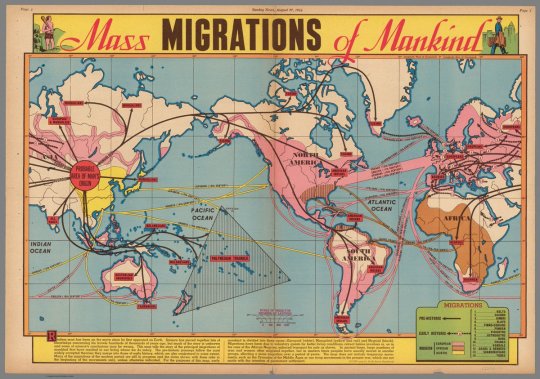
Remember, the oldest fossil remains at this point were in China, where Homo erectus was discovered (originally known by his initial place of discovery in Chungkotien Cave, nicknamed "Peking Man"). The discovery of Australopithecus and Homo habilis in Olduvai Gorge and South Africa, which place human origins in Africa, were not until the 50s and 60s, so it seemed entirely reasonable that Homo sapiens evolved in Western China.
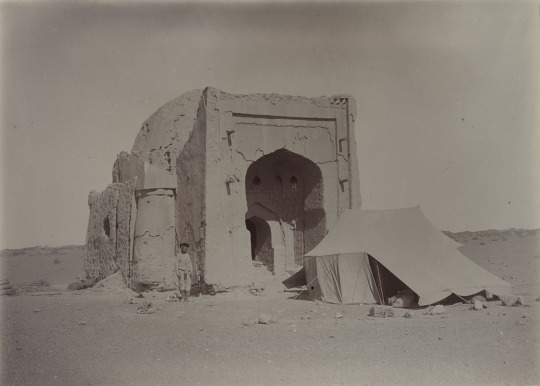
The idea that China's desert regions were the origin of modern humans and culture is seen a lot in pop culture from 1900-1950, mainly because there were tremendous explorations in the region, especially Aurel Stein's expedition of 1908, who ventured into the Taklamakan Desert to find the Dunhuang Caves and Khara-Khoto, a city destroyed completely by Genghis Khan and vanished in the desert.
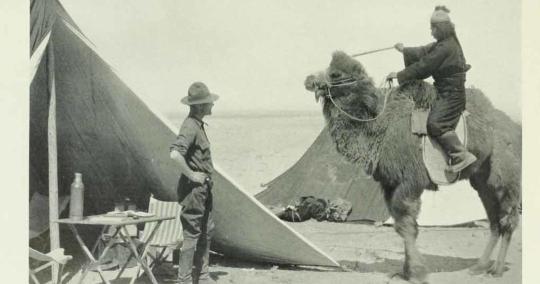
If you've ever heard of Roy Chapman Andrews and his famous expeditions in the 1920s, it's worth noting that he ventured into the Gobi Desert looking for human remains....not dinosaurs, and the discovery of dinosaur eggs was an unexpected surprise.
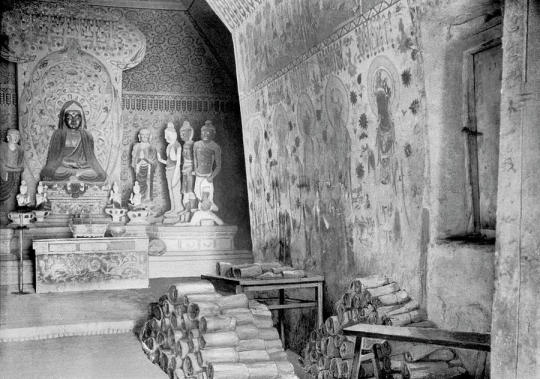
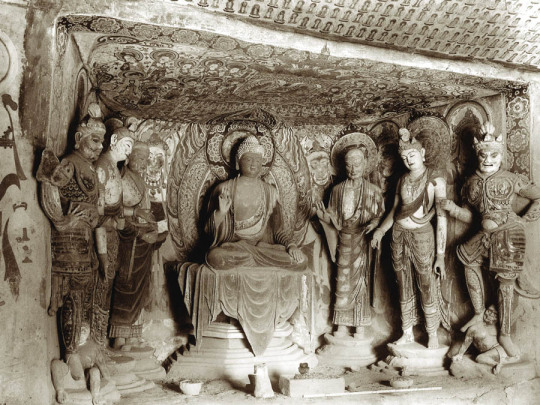
For that reason, there was a short lived Silk Road Mania that seemed to be a smaller scale predecessor to the pop culture dominating Egyptomania of the 1920s. It's bizarre to read adventure and fantasy fiction of the 1910s-1920s that features mentions of Silk Road peoples like the Kyrgyz, Sogdians, Tajik, Uigurians, and Tuvans. The best example I can think of would be the Khlit the Kossack stories of Harold Lamb (who also wrote a biography of Tamerlane), which together with Tarzan and Tros of Samothrace, formed the core inspiration for Robert E. Howard's Conan the Barbarian.
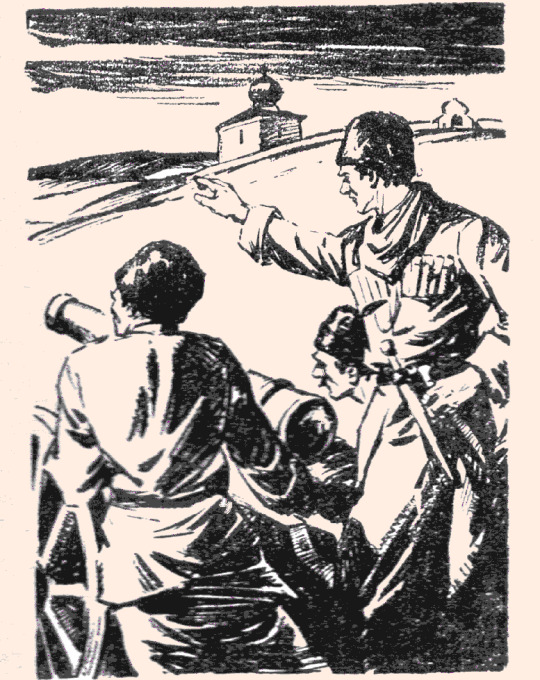
The most interesting example of this would be A. Merritt's Dwellers in the Mirage, which featured a lost city in Xinjiang that was the home of the Nordic race, who worshipped their original religion, the kraken-like squid devil god Khalkru. It was widely believed in this era that Nordics emerged from Central Asia originally, and while it's easy to write this off as turn of the century racialist claptrap pseudohistory (along with Hyperborea legends), in this case, it is actually true: a branch of the Indo-European family lived in West China, and 5,000 year old redheaded mummies have been found in the region. As usual, A. Merritt was right on the money with his archeology, more so than other 1920s authors. After all, his "Moon Pool" was set around the just discovered ruins of Nan Madol, the Venice of Micronesia.

Jack Williamson's still chilling Darker Than You Think in 1948 was also set in the Silk Road/Central Asian region, as the place the race of shapeshifters emerged from, Homo magi, who await the coming of their evil messiah, the Night King, who will give them power over the human race.

H. Rider Haggard set "Ayesha: the Return of She" (1905) in Xinjiang, among a lost Greek colony in Central Asia (no doubt based on Alexandria on the Indus, a Greek colony in modern Pakistan that was the furthest bastion of Greek Culture). This was also two years after the Younghusband Thibetan Expedition of 1903, where the British invaded Tibet. At the time, the Qing Dynasty was completely declining and lost control of the frontier regions, and the power vacuum was filled by religious authority by default (this is something you also saw in Xinjiang, where for example, the leader of the city was the Imam of Kashgar).
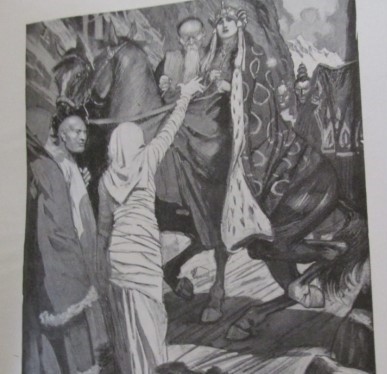
This is one of the many British invasions they have attempted to cram down the memory hole, but if you ever see a Himalayan art piece that was "obtained in 1903-1904" ....well, you know where it came from.
Incidentally, there's one really funny recent conspiracy theory about paleontology, fossils, and China that I find incredibly interesting: the idea that dinosaurs having feathers is a lie and a sinister plot spread by the Communist Chinese (who else?) to make American youth into sissy fancylads, like Jessie "the Body" Ventura. How? By lying to us and making up that the manly and vigorous Tyrannosaurus, a beast with off the charts heterosexuality and a model for boys everywhere, might have been feathered like a debutante's dress. What next - lipstick on a Great White Shark? The long term goal is to make Americans effeminate C. Nelson Reilly types unable to defend against invasion. This is a theory that is getting steam among the kind of people who used to read Soldier of Fortune magazine, and among abusive stepfathers the world over.

...okay, are you done laughing? Yeah, this is obvious crackpottery and transparent sexual pathology, on the level of the John Birch Society in the 60s saying the Beatles were a Communist mind control plot. Mostly because animals just look how they look, and if it turned out that the ferocious Tyrannosaurus had feathers and looked like a fancylad Jessie Ventura to you, well, that's your problem and mental baggage, really.
I was left scratching my head over this one. But there is (kind of) something to this, and that is that a huge chunk of recent dinosaur discoveries have been in China. I don't think it has anything to do with a Communist plot to turn American boys into fancylads, but more to do with a major push in internal public investment in sciences in that country, and an explosion of Chinese dinosaur discoveries. If you want to see a great undervisited dinosaur museum, go to the Zigong Dinosaur Museum in Sichuan.

Pop quiz: what living scientist has named more dinosaur discoveries? It's not Bakker or Horner. The greatest living paleontologist, Xu Xing, which is why a lot of recently found dinosaurs are named things like Shangtungasaurus.
250 notes
·
View notes
Text
The penetration of China by Buddhism not only gave the Chinese a new religion but, of central importance to this narrative, it gave to the world an entirely new style of art which has come to be known as Serindian. This term is coined from the two words Seres (China) and India. Logically it should have been simply a fusion of Indian Buddhist art and the art of contemporary Han China. It almost certainly would have been had it not been for the great Himalayan massif which so effectively isolated China from all direct contact with India. But faced by this impenetrable barrier, the gospel of Buddhism together with its art came to China by a roundabout route, gradually absorbing other influences on its way. Its real point of departure was not India proper but the Buddhist kingdom of Gandhara, situated in the Peshawar valley region of what is now north-western Pakistan. Here another artistic marriage had already taken place. This was between Indian Buddhist art, imported by the ruling Kushans (descendants of the Yueh-chih) in the first century AD, and Greek art, introduced to the region four hundred years earlier by Alexander the Great.
The most revolutionary product of this Graeco-Buddhist, or Gandharan, school was the depiction of Buddha in human form, for it was the first time that artists anywhere had allowed themselves to show him thus. As a being who had ceased to exist, theologically speaking, by achieving Nirvana and thus escaping the endless cycle of rebirth, he had always been portrayed before by means of a mystical symbol such as a single footprint, a wheel, a tree, a stupa or Sanskrit characters. But the Gandharan Buddha is shown by sculptors with straight, sharply chiselled nose and brow, classical lips and wavy hair–all Hellenistic influences. Another obvious Mediterranean introduction is the diaphanous, toga-like robe he wears in place of the expected loin cloth. But his eyes are heavy-lidded and protruding, the lobes of the ears elongated, and the oval-shaped face fleshy–all characteristics of Indian iconography. The stretched ear lobes symbolise Buddha’s casting away of the heavy, jewelled and worldly earrings that he had worn as a wealthy prince before his conversion to a life of self-denial and teaching
—Peter Hopkirk, Foreign Devils on the Silk Road: The Search for the Lost Cities and Treasures of Chinese Central Asia
#peter hopkirk#foreign devils on the silk road#history#china#india#gandhara#Buddhism#art#w#2024 reads#upl#reading through the silk road
28 notes
·
View notes
Text
On a stifling April afternoon in Ajmer, in the Indian state of Rajasthan, local politician Shakti Singh Rathore sat down in front of a greenscreen to shoot a short video. He looked nervous. It was his first time being cloned.
Wearing a crisp white shirt and a ceremonial saffron scarf bearing a lotus flower—the logo of the BJP, the country’s ruling party—Rathore pressed his palms together and greeted his audience in Hindi. “Namashkar,” he began. “To all my brothers—”
Before he could continue, the director of the shoot walked into the frame. Divyendra Singh Jadoun, a 31-year-old with a bald head and a thick black beard, told Rathore he was moving around too much on camera. Jadoun was trying to capture enough audio and video data to build an AI deepfake of Rathore that would convince 300,000 potential voters around Ajmer that they’d had a personalized conversation with him—but excess movement would break the algorithm. Jadoun told his subject to look straight into the camera and move only his lips. “Start again,” he said.
Right now, the world’s largest democracy is going to the polls. Close to a billion Indians are eligible to vote as part of the country’s general election, and deepfakes could play a decisive, and potentially divisive, role. India’s political parties have exploited AI to warp reality through cheap audio fakes, propaganda images, and AI parodies. But while the global discourse on deepfakes often focuses on misinformation, disinformation, and other societal harms, many Indian politicians are using the technology for a different purpose: voter outreach.
Across the ideological spectrum, they’re relying on AI to help them navigate the nation’s 22 official languages and thousands of regional dialects, and to deliver personalized messages in farther-flung communities. While the US recently made it illegal to use AI-generated voices for unsolicited calls, in India sanctioned deepfakes have become a $60 million business opportunity. More than 50 million AI-generated voice clone calls were made in the two months leading up to the start of the elections in April—and millions more will be made during voting, one of the country’s largest business messaging operators told WIRED.
Jadoun is the poster boy of this burgeoning industry. His firm, Polymath Synthetic Media Solutions, is one of many deepfake service providers from across India that have emerged to cater to the political class. This election season, Jadoun has delivered five AI campaigns so far, for which his company has been paid a total of $55,000. (He charges significantly less than the big political consultants—125,000 rupees [$1,500] to make a digital avatar, and 60,000 rupees [$720] for an audio clone.) He’s made deepfakes for Prem Singh Tamang, the chief minister of the Himalayan state of Sikkim, and resurrected Y. S. Rajasekhara Reddy, an iconic politician who died in a helicopter crash in 2009, to endorse his son Y. S. Jagan Mohan Reddy, currently chief minister of the state of Andhra Pradesh. Jadoun has also created AI-generated propaganda songs for several politicians, including Tamang, a local candidate for parliament, and the chief minister of the western state of Maharashtra. “He is our pride,” ran one song in Hindi about a local politician in Ajmer, with male and female voices set to a peppy tune. “He’s always been impartial.”
While Rathore isn’t up for election this year, he’s one of more than 18 million BJP volunteers tasked with ensuring that the government of Prime Minister Narendra Modi maintains its hold on power. In the past, that would have meant spending months crisscrossing Rajasthan, a desert state roughly the size of Italy, to speak with voters individually, reminding them of how they have benefited from various BJP social programs—pensions, free tanks for cooking gas, cash payments for pregnant women. But with the help of Jadoun’s deepfakes, Rathore’s job has gotten a lot easier.
He’ll spend 15 minutes here talking to the camera about some of the key election issues, while Jadoun prompts him with questions. But it doesn’t really matter what he says. All Jadoun needs is Rathore’s voice. Once that’s done, Jadoun will use the data to generate videos and calls that will go directly to voters’ phones. In lieu of a knock at their door or a quick handshake at a rally, they’ll see or hear Rathore address them by name and talk with eerie specificity about the issues that matter most to them and ask them to vote for the BJP. If they ask questions, the AI should respond—in a clear and calm voice that’s almost better than the real Rathore’s rapid drawl. Less tech-savvy voters may not even realize they’ve been talking to a machine. Even Rathore admits he doesn’t know much about AI. But he understands psychology. “Such calls can help with swing voters.”
13 notes
·
View notes
Text
Here's your incredible friendship story of the day:

In 1953, Edmund Hillary and Tenzing Norgay became the first two people to ever summit the highest mountain in the world, Mount Everest. Before the commercialised hiking expeditions of the 21st century, Hillary and Norgay had to make the climb without a pre-fixed route, discovering their own path to the top (one of which later became known as the Hillary Step in the Everest climbing trail).

The pair did not know each other well beforehand but met through their mountaneering peers. Norgay (a sherpa, Himalayan locals well-known for their mountaneering prowess) apparently made a lasting first impression on Hillary due to his incredible mountaneering skills, patience, complete with his "flashing, irresistible smile".
In one ocassion during their few earlier expeditions together, Hillary stepped on a crumbling ice and almost fell to his death before Norgay saved his life. This made him determined to ask Norgay to be his partner for his Everest Summit expedition.
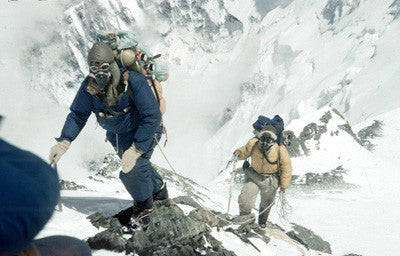
Amongst other members of the expedition, their pairing became the first one who were successful, reaching the highest point on Earth at 11:30 a.m. on May 29, 1953.
At the top, Hillary hilarously recalled extending his hand to shake Tenzing's hand in "a good Anglo-Saxon fashion," but his Nepalese-Indian friend jumped him on the back and gave him a massive hug instead. As he said, it was the “great moment for which I had waited all my life, [...] I waved my arms in the air and then threw them around Hillary, and we thumped each other on the back until, even with the oxygen, we were almost breathless!”.
But beyond this monumental achievement, the gentlemen's agreement they made at the top was perhaps an equally impressive commitment.

Being the only people in the world who were present, Norgay and Hillary made a promise to present their a success as a joint effort. Both countrymen were under international pressure to divulge who was actually the first to step foot on the summit. Despite the rising colonial tension at the times, both Norgay and Hillary refused to say anything other than they reached the summit together as a team, carrying the secret to their deathbeds.
After Everest, Hillary devoted his life to assisting the overlooked sherpa people of Nepal. He established the Himalayan Trust, constructing many schools and hospitals in Nepal. Norgay continued to climb mountains all over the world for the rest of his life and died in his beloved Himalayas.
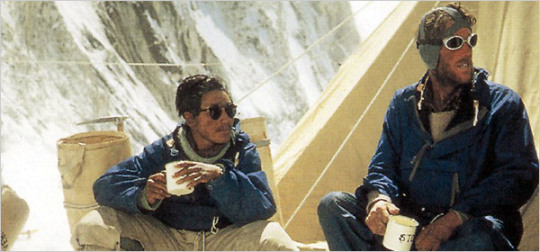
Hillary and Norgay remained lifelong friends, bonded for life. When Tenzing Norgay died in India in 1986, the country was in a massive political turmoil and all the streets in Darjeeling were closed due to confrontations with Nepalese separatists.
Edmund Hillary was the only foreigner allowed to enter the region, as reporters recounted how protesters parted ways to enable him to pay respects to his old friend.
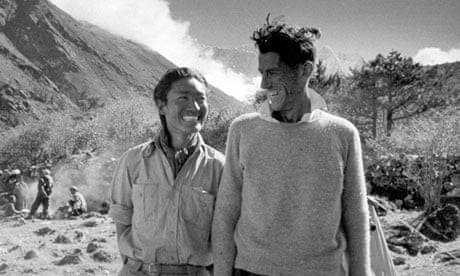
In 2003, their sons Peter Hillary and Jamling Norgay climbed Everest together, celebrating the 50th anniversary of their fathers' memorable climb that changed the world forever.

#friendships that transcended lifetimes#friendships that changed the world#this one quite literally!#them on top of everest tho 🥺#let's have a decent handshake lad- Nope let me give you a massive hug!!#i'm a sucker for incredible friendships#everest#climbing#tenzing norgay#edmund hillary#mountaneering#nepal#new zealand#tibet#india#himalayas
190 notes
·
View notes
Text

SEBASTIAN BEAR FATTENS UP FOR WINTER
Unlike the tropical sloth bear we talk about often, Himalayan brown bears live in areas with a temperate climate and hibernate during winter months when food is scarce. Gorgeous Sebastian (above) lives at our Dachigam Rescue Centre in Jammu and Kashmir (J&K), where the high elevations and brisk weather are better suited for him. J&K is in the far northwestern region of the Indian subcontinent in the foothills of Himalayan mountains.
Photo by Akash Dolas.
#akash dolas#photographer#wildlife sos#himalayan brown bear#bear#mammal#animal#wildlife#hibernation#dachigan rescue centre#jammu and kashmir#india#indian subcontinent#himalayan mountains#nature
32 notes
·
View notes
Text
Kabru's name
(I’ll provide some links in a reply, so Tumblr doesn’t eat this)
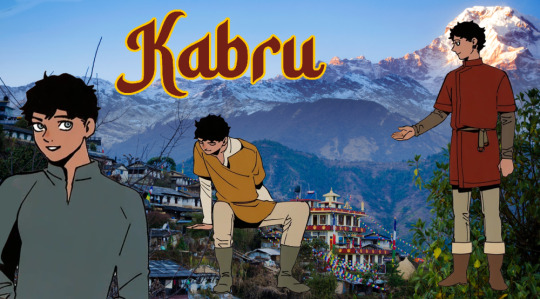
(UPDATE: Full version of this research is available here!)
Fun Dungeon Meshi facts! Kabru’s name is also the name of one of the peaks of the Himalayan mountain chain. It’s on the border between India and Nepal, which fits with Kabru’s skin and hair color (and texture). Also a lot of clothes and color choices Kui makes in the Daydream hour supplements really give me a Nepalese vibe, especially that red tunic. Lighter colored eyes are also not unheard of in that region, though obviously blue is still rare.
Utaya is also the name of a real place! It’s a small village (population of 98 people) at the foot of a mountain in the sub-arctic region in north-eastern Russia, and the name ‘Utaya’ is from the Yakut language, which has Turkic origins. Utaya also means ‘mandible’ in Swahili, and possibly is a name that means ‘Always bright’ in Hindi? Can’t confirm those last two.
Anyway all that to say that I HC Utaya having a culture influenced by Nepal and India, and I HC Kabru’s mom being named Annapurna, which is another mountain in the Himalayan range, named after the goddess of food - what could be more fitting for Dungeon Meshi, right?
I also HC Kabru having a big dick cuz he’s named after a mountain and quite popular with the ladies but that’s really not that important i just think it’s funny
Some pics of Nepalese and Indian men that reminded me of Kabru under the cut, along with some more general pictures of the people of Nepal. Enjoy and do what you will with the fruits of my research!



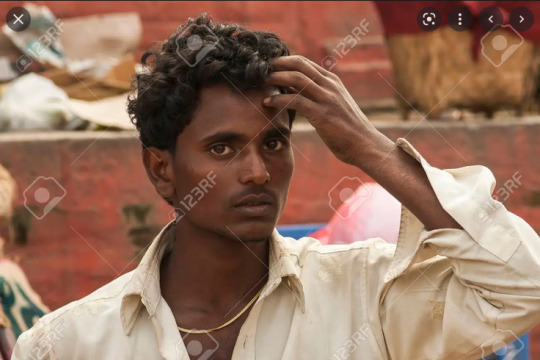
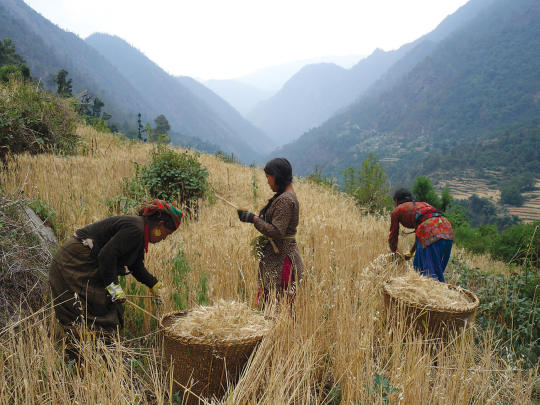

#dungeon meshi#delicious in dungeon#kabru#dunmeshi#ダンジョン飯#headcanons#my stuff#Dungeon Meshi Research
218 notes
·
View notes
Text

Ngakpas
Ngakpa (Tib. སྔགས་པ་, Wyl. sngags pa ) are both healers and practitioners of the highest levels of Tantric Buddhism in the Himalayan regions.
The origins of Ngakpas is connected to Guru Rinpoche who, in Tibet during the 8th century, divided the Sangha into two branches: the red sangha of monastics with shaven-heads and the saffron robes (Wyl. rab byung ngur smig go see) and the white sangha of Ngakpas with white clothes and long, plaited hair (Wyl. gos dkar lcang lo’I see).
A realized Ngakpa can perform ceremonies to pacify illness, disease and help in other worldly activities and be a master of the inner levels of Tantra and Dzogchen practices dealing with liberation on others. However, many people confuse them as 'shamans' or just 'lay practitioners' and often times they were belittled by those who are unaware of their history and importance as the torchbearers of an ancient Indian tradition.
As Khetsun Sangpo Rinpoche said, “for the ngakpa the purpose and final goal is enlightenment in order to liberate others and self. Usually in the shamanic tradition no one talks of enlightenment.”
According to Kunzang Dorje Rinpoche,
There are two types of ngakpas – those of family lineage (rigs rgyud) and those of Dharma lineage (chos rgyud). Ngakpa family lineages are passed from father ngakpa to their sons from generation to generation. At present, these are family lineage holders such as the great lamas of the Nyingma tradition, Minling Trichen Rinpoche and Sakya Trizin, the throne holder of the Dharma Potrang lineage
Ngakpas, known in Tibetan as "སྔགས་པ" (sngags pa), play a significant role in the spiritual and healing traditions of the Himalayan regions. Their origins are deeply intertwined with the profound teachings of Guru Rinpoche, who, during the 8th century in Tibet, initiated a division within the Sangha, the Buddhist monastic community.
Guru Rinpoche's division resulted in two distinct branches. The first is the "red sangha," composed of monastics who wear shaven heads and saffron robes. The second is the "white sangha" of Ngakpas, characterized by white clothing and long, plaited hair. This division reflects the diverse paths to spiritual realization within Tantric Buddhism.
Ngakpas are highly regarded for their unique roles as both healers and practitioners of the highest levels of Tantric Buddhism. A realized Ngakpa possesses a deep understanding of Tantric and Dzogchen practices, which focus on inner transformation and the path to enlightenment. Their abilities extend beyond the conventional boundaries of spiritual practices, allowing them to perform ceremonies aimed at pacifying illness, disease, and assisting in various worldly activities.
Contrary to common misconceptions, Ngakpas are not shamans or mere lay practitioners. They are torchbearers of an ancient Indian tradition with a distinct focus on achieving enlightenment for the benefit of both themselves and others. In this sense, they are more aligned with the traditional Buddhist goals of liberation and awakening.
Khetsun Sangpo Rinpoche eloquently summarizes this distinction when he emphasizes that for Ngakpas, the ultimate purpose and goal are enlightenment, a goal rarely discussed in shamanic traditions. The focus on spiritual realization sets Ngakpas apart from practices primarily concerned with worldly or material concerns.
Furthermore, Ngakpas come in two main categories: those of family lineage (rigs rgyud) and those of Dharma lineage (chos rgyud). Family lineage Ngakpas inherit their role from their fathers, passing down the tradition through generations. Prominent figures within this tradition include the great lamas of the Nyingma tradition, such as Minling Trichen Rinpoche and Sakya Trizin, the throne holder of the Dharma Potrang lineage.
In conclusion, Ngakpas are a unique and essential part of the Himalayan spiritual landscape. Their roots in the teachings of Guru Rinpoche, their dual role as healers and practitioners, and their dedication to the path of enlightenment distinguish them from other spiritual traditions. It is crucial to recognize and honor the history and importance of Ngakpas as preservers of an ancient Indian tradition and torchbearers of the quest for spiritual awakening and liberation.
#buddha#buddhism#buddhist#dharma#sangha#mahayana#zen#milarepa#tibetan buddhism#thich nhat hanh#padmasambhava#Guru Rinpoche#four noble truths#buddha samantabhadra
22 notes
·
View notes
Text
Planting trees does not necessarily mean a forest is being restored.
---
But efforts to increase global tree cover to limit climate change have skewed towards erecting plantations of fast-growing trees. The reasons are obvious: planting trees can demonstrate results a lot quicker than natural forest restoration. This is helpful if the objective is generating a lot of timber quickly or certifying carbon credits which people and firms buy to supposedly offset their emissions. [...] [I]ll-advised tree planting can unleash invasive species [...]. For more than 200 years India has experimented with tree plantations, offering important lessons about the consequences different approaches to restoring forests have on local communities and the wider environment. This rare long-term perspective should be heeded [...].
Britain extended its influence over India and controlled much of its affairs [...] from the mid-18th century onwards. Between 1857 and 1947, the Crown ruled the country directly and turned its attention to the country’s forests. Britain needed great quantities of timber to lay railway sleepers and build ships in order to transport the cotton, rubber and tea it took from India.
Through the Indian Forest Act of 1865, forests with high-yielding timber trees such as teak, sal and deodar became state property. To maximise how much timber these forests yielded, British colonial authorities restricted the rights of local people to harvest much beyond grass and bamboo. [...] Meanwhile plantations of teak (Tectona grandis), a species well adapted to India’s hot and humid climate and a source of durable and attractive timber, spread aggressively. [...]
---
[G]rasslands and open scrub forest gave way to teak monocultures.
Eucalyptus and other exotic trees which hadn’t evolved in India were introduced from around 1790. British foresters planted pines from Europe and North America in extensive plantations in the Himalayan region as a source of resin and introduced acacia trees from Australia for timber, fodder and fuel.
One of these species, wattle (Acacia mearnsii), first introduced in 1861 with a few hundred thousand saplings, was planted in the Nilgiris district of the Western Ghats. This area is what scientists all a biodiversity hotspot – a globally rare ecosystem replete with species. Wattle has since become invasive and taken over much of the region’s mountainous grasslands.
Similarly, pine has spread over much of the Himalayas and displaced native oak trees while teak has replaced sal, a native hardwood, in central India. Both oak and sal are valued for fuel, fodder, fertiliser, medicine and oil. Their loss [...] impoverished many.
---
India’s national forest policy [...] aims for trees on 33% of the country’s area. Schemes under this policy include plantations consisting of a single species such as eucalyptus or bamboo which grow fast and can increase tree cover quickly, demonstrating success according to this dubious measure. Sometimes these trees are planted in grasslands and other ecosystems where tree cover is naturally low. The result is that afforestation harms rural and indigenous people who depend on these ecosystems [...].
In the Kachchh grasslands of western India communities were able to restore grasslands by removing the invasive gando bawal (meaning “mad tree”) first introduced by British foresters in the late 19th century. [...]
The success of forest restoration efforts cannot be measured by tree cover alone. The Indian government’s definition of “forest” still encompasses plantations of a single tree species, orchards and even bamboo, which actually belongs to the grass family. This means that biennial forest surveys cannot quantify how much natural forest has been restored, or convey the consequences of displacing native trees with competitive plantation species or identify if these exotic trees have invaded natural grasslands which have then been falsely recorded as restored forests. [...]
Planting trees does not necessarily mean a forest is being restored. And reviving ecosystems in which trees are scarce is important too.
---
Text by: Dhanapal Govindarajulu. "India was a tree planting laboratory for 200 years - here are the results." The Conversation. 10 August 2023. [Bold emphasis, some paragraph breaks/contractions, and italicized first line in this post added by me.]
141 notes
·
View notes
Text
Excerpt from this New York Times story:
New Delhi recorded its highest temperature ever measured on Wednesday — 126 degrees Fahrenheit, or 52.3 degrees Celsius — leaving residents of the Indian capital sweltering in a heat wave that has kept temperatures in several Indian states well above 110 degrees for weeks.
In New Delhi, where walking out of the house felt like walking into an oven, officials feared that the electricity grid was being overwhelmed and that the city’s water supply might need rationing.
The past 12 months have been the planet’s hottest ever recorded, and cities like Miami are experiencing extreme heat even before the arrival of summer. Scientists said this week that the average person on Earth had experienced 26 more days of abnormally high temperatures in the past year than would have been the case without human-induced climate change.
Although late-afternoon dust storms and light drizzle in New Delhi had brought hope of some reprieve on Wednesday, the weather station at Mungeshpur, northwest of the capital, reported a recording of 126 degrees around 2:30 p.m. Dr. Kuldeep Srivastava, a scientist at the regional meteorological center in Delhi, said it was the highest temperature ever recorded by the automatic weather monitoring system, which was installed in 2010.
In a statement later on Wednesday evening, India’s meteorological department said the Mungeshpur station was “an outlier compared to other stations.” It said it was assessing whether that station’s recording of a higher temperature than other stations around Delhi was due to an error or a local mitigating factor.
The previous record for the highest temperature, around 48 degrees Celsius — about 118.5 Fahrenheit — was repeatedly crossed in recent days. Three of New Delhi’s weather stations reported temperatures of 49.8 degree Celsius — 121.8 degrees Fahrenheit — or higher on Tuesday, setting a new record even before the 52.3 degree reading on Wednesday afternoon.
For weeks now, temperatures in several states in India’s north have reached well over 110 degrees, and hospitals have been reporting an uptick in cases of heatstroke. In the Himalayan states, hundreds of forest fires have been reported.
7 notes
·
View notes
Text
As an armed rebellion against Indian rule raged in Kashmir through the 1990s and 2000s, Jamaat-e-Islami, an influential socio-religious group, called for a boycott whenever an election was held, claiming the exercise was aimed at legitimising what it would describe as New Delhi’s occupation of the Himalayan region, which is also claimed in part or full by Pakistan and China.
But as Kashmir votes in the first regional election in a decade starting on Tuesday, the Jamaat has itself entered the political fray, backing at least 10 candidates in the election. It is a remarkable turnaround for a group that remains banned under India’s anti-terror laws and was once regarded as the mothership of the militant Hizbul Mujahideen.
After Narendra Modi’s government altered India’s constitution in 2019 to do away with the symbolic autonomy of the administrative region of Jammu and Kashmir, it cracked down hard on the separatist movement in the region, jailing thousands of people. The Jamaat, having long been at the vanguard of the movement, was a prime target. Schools associated with the group were ordered shut and the properties of many members were seized in an attempt to curtail its reach and operational capabilities.
As recently as February, the Indian government said that the Jamaat was “continuing to be involved in fomenting terrorism and anti-India propaganda for fuelling secessionism in Jammu and Kashmir, which is prejudicial to the sovereignty, security and integrity of India”.
This is what makes the Jamaat’s participation in the election perplexing, and even experts in the region are divided over what it means. Noor Baba, a renowned Kashmiri political scientist, says it could be a tactical move on the part of a minority within the movement – contesting the election as independents in the hope of “protection or rehabilitating themselves after the suffering they have endured”.
The decision to join the fray, he suggests, may not have involved the group’s jailed leadership. As a result of internal divisions in the past, Prof Baba says, the Jamaat has suffered at the hands of both the Indian authorities as well as the militants. Similar divisions may have cracked open again.
“There are many questions,” he tells The Independent. “Is the top leadership, which is in jail, on board with this or is it not?”
Another theory is that the decision stems from the Jamaat’s desire to have the anti-terror ban lifted. There have been reports about conversations between the Jamaat and intermediaries of the Indian government such as Altaf Bukhari, head of a local political party.
Ahead of this election, Omar Abdullah, the former chief minister of the former state, had urged the Narendra Modi government to lift the ban on the Jamaat to enable its participation in the assembly election. Mehbooba Mufti, another former chief minister and president of the People’s Democratic Party, said she would be “happy” to see the Jamaat return to the electoral arena.
Indian political analyst Apoorvanand Jha, however, sees a more sinister play at work. He says fielding independent candidates is part of a broader strategy of Modi’s BJP to weaken mainstream political parties such as the National Conference and the Congress and reap the dividend.
“The BJP’s aim is to install a government headed by a Hindu chief minister. That can be achieved by securing as many seats as possible in the Jammu region and fielding as many independents as possible in the valley [of Kashmir], making them win and then taking their support to form the government,” he tells The Independent.
The BJP is seeking to control Kashmir politically by creating chaos, he says. “To achieve that,” he adds, “the BJP can do anything. It can go to any extent, play any game, collaborate with the radicals, collaborate with separatists.”
The Independent has contacted the BJP for comment.
India has long held up Kashmir, its only majority Muslim territory, as a symbol of its secularism. But when the BJP government revoked its autonomy, Kashmiris accused the Hindu nationalist party of trying to change its religious demographic by settling Indians from elsewhere in the region.
Mr Jha says the BJP wants to win the election in order to show its core Hindu base that “see, this is a Muslim-populated area which we have now annexed”.
The candidates backed by the Jamaat maintain that their election participation is about local issues.
“Ideologies work in time and space. We have to be accommodative and flexible,” Talat Majeed, who is contesting the Pulwama constituency, told reporters recently.
Another candidate, Sayar Ahmad Reshi, says their participation in the election is necessary to fill a political vacuum created by regional parties such as the National Conference and the People’s Democratic Party.
The Jamaat’s participation seems to have enthused some pro-India factions in Kashmir. “This election is unique in recent times because the banned Jamaat-e-Islami is openly backing and campaigning for independent candidates owing allegiance to it,” Mr Abdullah said in an interview with the Hindustan Times. “This is a huge change from previous elections. Otherwise, ever since I have seen politics here from 1996 onwards, the Jamaat has been at the forefront of trying to stop people from voting.”
Ali Mohammad Watali, a former police chief of Kashmir, isn’t as enthused. The Jamaat was “pro-Pakistan and pro-terrorism”, he was quoted as saying by Frontline magazine. “Now they have changed their stance suddenly. It looks like this is being done by the agencies so that the BJP can form a government here with the help of new political fronts, including the Jamaat-e-Islami.”
“Agencies” is a catch-all term used in Kashmir for the intelligence, security and surveillance apparatus of the Indian state.
The Jamaat candidates have indicated their willingness to form alliances, before or after the election, with any party that works to “restore dignity to the people of Jammu and Kashmir”.
Prof Saddiq Wahid, a senior visiting fellow at the Centre for Policy Research think tank in New Delhi, tells The Independent the BJP’s actions in Jammu and Kashmir since the revocation of its autonomy have been aimed at creating confusion and chaos. “How is Jamaat suddenly into the picture?” he asks.
He fears that the political landscape of Kashmir is being manipulated to dilute local representation and prevent self-governance.
“They do not want the people of Jammu and Kashmir to have a government that will allow them to govern themselves,” he says, referring to the Indian government.
The fundamental question, though, is whether people will trust the candidates backed by the Jamaat, Prof Baba points out. “How many people will vote for them, support them?”
3 notes
·
View notes
Text
History And Origin of Nepal: A journey through time
Lying right in the middle of the Himalayas between India and China, Nepal is a country that is full of a whole of history. The story it tells is of myths, legends, dynasties, and influences that flowed on the waves of both the Indian subcontinent and the Tibetan plateau. The origin of Nepal seems to be completely intertwined with geographical elements, religion, and cultural heritage. In this blog, one is introduced to the historical journey of Nepal and formation of Himalayas, from its root to the formation of a modern nation.
Mythological Beginnings: Legends of Nepal's Formation
The history of Nepal opens with mythological accounts about the origin. Ancient legends say that Kathmandu Valley was once a huge lake, inclusive of what today is considered the cultural and historical heart of Nepal. According to this, a Buddhist saint called Manjushree, coming from China, saw a lotus flower falling in the middle of the lake and wanted to reach it. At Chobar, he cut a gorge with his sword thereby allowing it to drain the water so that the valley could be habitable. Thus, the fertile land of the Kathmandu Valley came into being. This mythical event is symbolic of the birth of Nepal.
Another popular legend describes how the god Vishnu, in the avatar of a boar, or Varaha, raised Nepal out of the waters. These myths said much not only about how the people of Ancient Nepal viewed their land but also revealed the deep religious meaning always permeating Nepalese culture.
Unification of Nepal: The Rise of the Shah Dynasty
Nepal’s political landscape changed dramatically in the 18th century with the rise of Prithvi Narayan Shah, the ruler of the small principality of Gorkha. He embarked on a campaign to unify the various fragmented kingdoms and principalities of the region. After several attempts, Prithvi Narayan Shah successfully conquered the Kathmandu Valley in 1768, marking the beginning of the Shah dynasty and the creation of modern Nepal. Prithvi Narayan Shah's unification campaign laid the foundation for a strong, centralised kingdom. He strategically kept Nepal independent from both the expanding British Empire in India and the Qing Dynasty in China by maintaining a policy of isolation and diplomacy.
The Collision of India and Eurasia: Birth of the Himalayas
Nepal is home to Himalayas: the home to world's highest peaks, including Mt. Everest.The story of the Himalayas really started when the Indian subcontinent, shortly after it broke away from Gondwana around 100 million years ago, began its drift northward. There laid between the Indian plate and the Eurasian plate at that time the Tethys Ocean. In this process, the Indian plate was submerged underneath the Eurasian plate, and it is both slow and powerful. These movements created strong geological forces which pushed up the sedimentary rocks of the Tethys Ocean, hence creating the Himalayan mountain range.
The impact of the collision caused the Earth's crust to fold, that formed the towering peaks of the Himalayas. The immense pressure created large thrust faults, which caused the land to rise vertically. Over time, these processes built some of the highest mountains in the world, including Mount Everest (8,848 meters) and Kangchenjunga (8,586 meters), both of which are located in the Nepalese Himalayas.
Geological Zones of the Nepal Himalayas
The Nepalese Himalayas were divided into a number of distinct geological zones, which reflect their complex history of formation. These include the following:
Terai Plains: This is a flat, fertile region situated on the southernmost part of Nepal, marking the northern edge of the Indo-Gangetic plains. They actually were formed by sediments deposited by the rivers flowing down from the Himalayas.
Siwalik Hills: Lying just north of the Terai, Siwalik Hills are the youngest part of the Himalayas that were uplifted about 10 to 20 million years ago. It is a folded and faulted rock area which has been uplifted relatively recently.
3.The Mahabharat Range: This range lies north of Siwalik, much older, loftier, and with steeply descending slopes enclosing profound valleys. Metamorphic and sedimentary rocks common in this region bear the telltale presence of the gradual uplift that has occurred here over millions of years.
4.Lesser Himalayas: This zone lies north of the Mahabharat Range and consists of a series of hills and ridges that rise up to about 4,000 meters. The Lesser Himalayas are made up of older rocks, mainly sedimentary and metamorphic uplifted during the early phase of collision between the Indian and Eurasian plates.
5.Greater Himalayas: Higher or Greater Himalayas forms the central backbone of this mountain and contains all the highest peaks including Mt. Everest and Kangchenjunga. Ancient metamorphic rocks, mainly schist and gneiss, are dominant in this zone, which has undergone extreme heat and pressure for millions of years.
6.Tibetan Plateau: The Tibetan Plateau forms the northern boundary of the Greater Himalayas, and is rightly called the "Roof of the World." This high-altitude plateau, in turn, had been raised as the Indian plate moved northward and was thrust underneath the Eurasian plate.
Thus, the history of Nepal represents a tapestries history with myths, conquests, cultural achievements, and political upheavals. Starting from the mythological beginnings down to its present-day status as a republic.The history of the Himalayas in Nepal is a long geology that has taken millions of years to unfold. From the first collision between the Indian and Eurasian plates to the towering peaks that now define the region, the Himalayas remain a living testimony to the dynamic forces shaping our planet. That spectacle of beauty and grandeur, yet at the same time a grim reminder of the immense power of nature and the precarious balance between the geological processes of Earth and the fragile ecosystems which find life in their shadow. Nepal's journey through history has taken a path no less dramatic than the landscape it inhabits. As the nation continues to grow, its past shapes its future, guided by the aspirations of the people that populate it.
2 notes
·
View notes